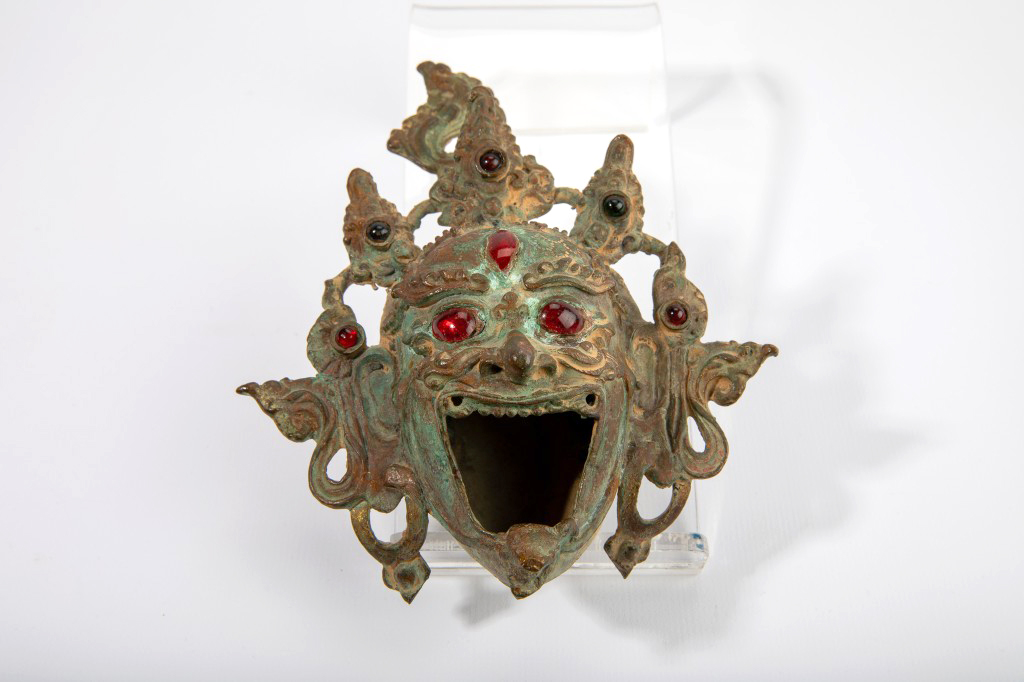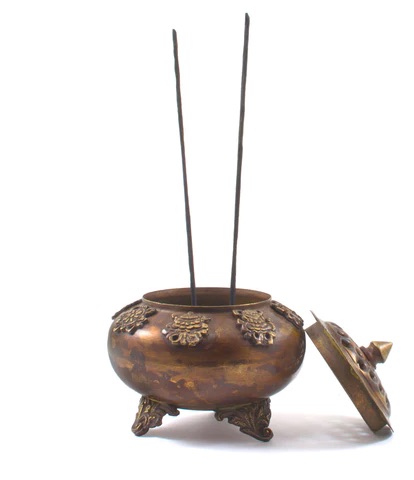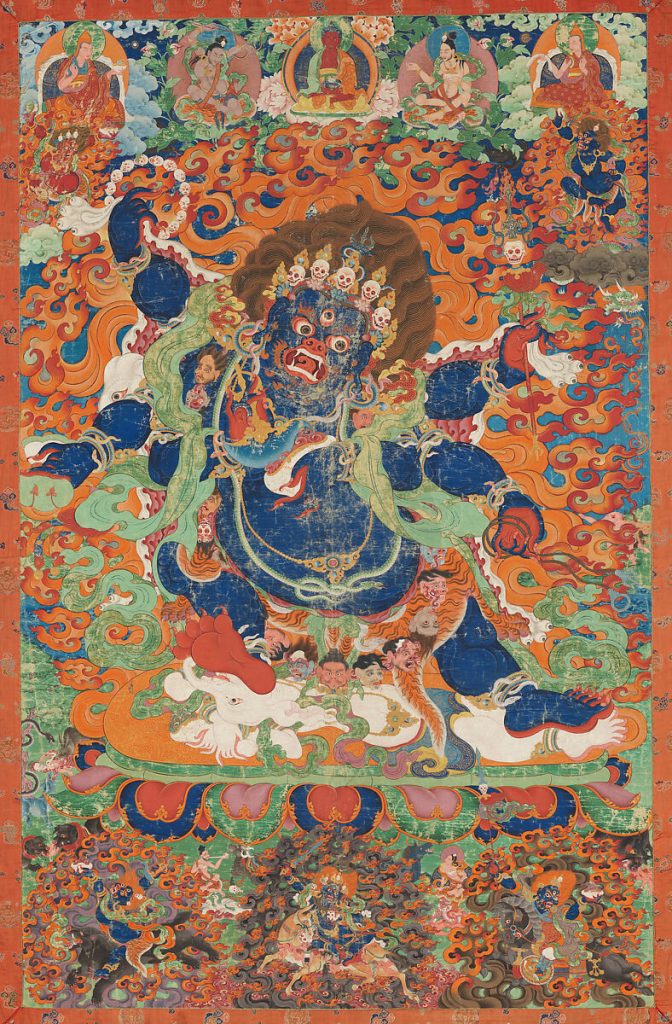Mahakala Incense Burner
Mahakala Incense Burner

Mahakala Incense Burner
Undated
Copper alloy and semi-precious stones
1994.219
This artwork depicts Mahakala, the Tibetan God of Time, Destruction, and Power.1 Mahakala is a Sanskrit word, where Maha means great and Kala refers to time or death.2 In Tibetan Buddhism, Mahakala is also known as Nagpo Chenpo, the Great Black One.3 The deity Mahakala originated as a wrathful form taken by Avalokitesvara, the Bodhisattva of Great Compassion, to fulfill his promise of subduing degenerates and liberating sentient beings from samsara.4 Despite his core compassionate nature, Mahakala is often depicted as a fierce and terrifying deity that appears evil, like a demon.5 This is because his wrathful appearance allows him to function as a “guard dog” or “guardian” which helps one overcome negative obstacles on the path to enlightenment.6 This artwork is an example of such a depiction and can be identified as the “angry type” deity or the “fiercest fiend” based on its stylistic characteristics. This iconographic form is known for its elaborate ugliness, scowling brows, cruel and callous eyes, and often a third eye in the center of the forehead,7 all of which are evident in this particular artwork. The menacing expression of the “fiercest fiend” is conveyed through the depiction of great canine fangs and chaplets of skulls encircled by tongues of flame in this artwork.8
In addition, Mahakala’s crown of five skulls in this artwork symbolizes the five poisons – anger, desire, ignorance, jealousy, and pride – being transformed into five wisdoms, as Mahakala is also known as the protector of wisdom.9 The blazing fire behind his crown symbolizes his action to consume the five destructive states of mind discussed above so that his worshippers could be freed from these obstacles and reach enlightenment.10 Upon burning incense in the Mahakala-shaped burner, the deity is figuratively consuming the five destructive vices.11 Mahakala’s figurative consumption of vices shifts the attention of the worshippers from the physical appearance of Mahakala to their known progress toward enlightenment.12
Interestingly, Buddhists often worship Mahakala’s wrathful energy, which can be completed through the burning of juniper incense.13 Often, juniper helps an individual meditate by fostering a more “apparent consciousness”, which represents a deeper awareness of one’s surroundings, thoughts, and emotions.14 Since Mahakala is believed to consume destructive thoughts, one might speculate that burning incense in Mahakala symbolizes the burning up of one’s own negative thoughts. Thus, as the solid incense transforms into smoke, it purifies one’s mind, leaving behind no traces of negative thoughts and facilitating the path toward enlightenment. The act of burning could be interpreted as the wrathful aspect of Mahakala, while the smoke represents Mahakala’s compassion in helping one reach enlightenment.

This incense burner is not only striking in its visual appearance, but it is also highly regarded for its material composition as well. While copper has a distinct reddish-orange color in its pure state, it can also develop a green or blue-green patina over time when exposed to air and moisture. Upon visual analysis, this incense burner shows clear signs of this blue-green patina, indicating that the object is likely made of copper or contains copper as an alloy. Therefore, this artwork is likely revered within Tibetan Buddhism, where gilt-copper images hold particular esteem.15 The use of gilt copper in Tibetan Buddhism is highly treasured because it is a rare material for Buddhist ritual artworks.16 Also, those adorned with rubies, turquoise, and other gemstones are considered especially valuable in Tibetan Buddhism art because of their precious nature and rarity.17
The incense burner in the shape of the head of Mahakala exemplifies the intersection between art and ritual in Asia, particularly within the context of Tibetan Buddhism. The intimidating visual features of this incense burner are intentionally created so that the deity represented, Mahakala, could intimidate and overcome any obstacles on the Buddist worshipper’s way to enlightenment.18 Through the ritual practice of burning incense, the worshipper’s thoughts are symbolically purified and replaced by a more “apparent consciousness”, facilitating their journey toward enlightenment. By studying artworks like this incense burner, one can gain a greater appreciation for the religious practices in Asia, such as Tibet Buddhism, and how they are manifested in art. Overall, the Mahakala incense burner is one of many instruments in this virtual exhibition that showcase and celebrate Asia’s rich artistic and spiritual traditions.
Anna Claire Mitchell
Architecture and the Built Environment; Human and Organizational Development
Class of 2025
Wonder Wei
Ecology, Evolution, and Organismal Biology
Class of 2024
Annotated Bibliography
Bazin, Nathalie. “Fragrant Ritual Offerings in the Art of Tibetan Buddhism.” Journal of the Royal Asiatic Society of Great Britain & Ireland 23, no. 1 (2013): 31–38. https://doi.org/10.1017/s1356186312000697.
In this article, Nathalie Bazin, an anthropologist discusses the importance of incense and fragrant offerings in Tibetan Buddhism. First, she describes perfumes as a symbol of perseverance, aiding individuals in achieving enlightenment. When burning incense, individuals use juniper leaves, often sacred to many people in the Himalayan region. The cinnamon-like scent of juniper is known to have psychedelic effects and enhances Buddhist purification rituals.
Beer, Robert. The Handbook of Tibetan Buddhist Symbols. Boston: Shambhala, 2003.
In this book, Beer analyzes an array of symbols and motifs from Tibetan Buddhism and offers explanations of their purposes. Among them, Beer writes about the Mahakala deity and its attributes. He discusses the relationship between wrathful figures and human body parts. Beer describes the Mahakala deity feeding a human heart and veins into its mouth. This process symbolizes the destruction of desire and demonic forces that hinder spiritual practices. It is evident that Beer suggests that the consummation of human parts serves as a symbol for the completion stage of Buddhist practice. In this phase, a person’s body, speech, and mind awaken.
Rinpoche, Lodru. “The Legend of Mahakala.” Buddhist Himalaya 4, no. 1 (1992).
In this text, Lama Lodru Rinpoche briefly discusses Mahakala’s origin and Mahakala’s symbolism. He suggests that Mahakala is the wrathful form of Avalokitesvara because this Bodhisattva needs a fearsome form to help Buddhists overcome obstacles to enlightenment. Lama Lodru Rinpoche is the appointed resident lama of Kagyu Droden Kunchab in San Francisco and thus has first-hand access to extensive sacred texts, such as the ones on Mahakala. This source is relevant and useful because it demonstrates how Mahakala’s origin explains its intimidating depictions.
Rana, Poonam. “Intangible Aspects Attached to the Mahākāla Worship in Hindu and Buddhist Text”. SIRJANĀ – A Journal on Arts and Art Education 5 (2018): 38-49. https://doi.org/10.3126/sirjana.v5i1.39741.
In the text, Rana describes that the interpretation of the name Mahakala means “the great black one.” Despite its grim meaning, the Mahakala is a benevolent force that helps individuals destroy obstacles that hinder the path of enlightenment. His combative nature is necessary because it allows him to cleanse negative energies away from a person and redirect their practice to devotion and positive action. The more an individual worships and praises the Mahakala deity, the more good fortune they will receive.
Rana, Poonam. “The Sacred Mahakala in the Hindu and Buddhist Texts.” Nepalese Culture 13 (2019): 77–84. https://doi.org/10.3126/nc.v13i0.27503.
In this article, Rana argues that Mahakala is a critical deity to Hinduism and Buddhism. Specifically, Rana translates the meaning of Mahakala as the Great Black One and claims that Mahakala’s wrathful appearance allows it to help Buddhists reach enlightenment by being a guardian. Rana’s article is credible because the author is a Ph.D. at Tribhuvan University in Nepal and examines primary texts. This source is significant and valuable because it explains the reasoning and function of Mahakala’s depictions as a terrifying deity.
Waddell, Laurence Austine. The Buddhism of Tibet or Lamaism. Cambridge: W. Heffer and Sons Limited, 1971.
In this book, Waddell writes about Tibetan Buddhism, its history, tradition, folklore, and art. Particularly, he states that copper sculptures are the most prized among Tibetan Buddhist artwork. The “angry deities” usually have certain sets of visual characteristics like a third eye and scowling brows. His sources are from his direct contact with the Tibetans and primary visual evidence because he would like to have first-hand and reliable information sources with as little western bias as possible. This source proves relevant and valuable because it sheds light on the high value of the incense burner and provides iconographic information on “angry deities” in Tibet Buddism, a category of deity that Mahakala belongs to.
- Rana, Poonam. “The Sacred Mahakala in the Hindu and Buddhist Texts.” Nepalese Culture 13 (2019): 77. ↩︎
- Rana, “The sacred Mahakala in the Hindu and Buddhists texts”, 77. ↩︎
- Rana, “The sacred Mahakala in the Hindu and Buddhists texts”, 77. ↩︎
- Rinpoche, Lodru. “The Legend of Mahakala.” Buddhist Himalaya 4, no. 1 (1992) ↩︎
- Rana, “The sacred Mahakala in the Hindu and Buddhist texts”, 84. ↩︎
- Rana, “The sacred Mahakala in the Hindu and Buddhist texts”, 84. ↩︎
- Waddell, Laurence Austine. The Buddhism of Tibet or Lamaism (Cambridge: W. Heffer and Sons Limited, 1971), 334. ↩︎
- Waddell, The Buddhist of Tibet or Lamaism, 335. ↩︎
- Rinpoche, “The Legend of Mahakala”. ↩︎
- Rinpoche, “The Legend of Mahakala”. ↩︎
- Rana, Poonam. “Intangible Aspects Attached to the Mahākāla Worship in Hindu and Buddhist Text”. A Journal on Arts and Art Education 5, (2018): 43. ↩︎
- Nathalie Bazin, “Fragrant Ritual Offerings in the Art of Tibetan Buddhism,” Journal of the Royal Asiatic Society of Great Britain & Ireland 23, no. 1 (2013): 31–38. ↩︎
- Bazin, “Fragrant Ritual Offerings in the Art of Tibetan Buddhism”, 33-34. ↩︎
- Robert Beer, The Handbook of Tibetan Buddhist Symbols (Boston: Shambhala, 2003), 165. ↩︎
- Waddell, The Buddhist of Tibet or Lamaism, 329. ↩︎
- Waddell, The Buddhist of Tibet or Lamaism, 329. ↩︎
- Waddell, The Buddhist of Tibet or Lamaism, 329. ↩︎
- Rana, “The sacred Mahakala in the Hindu and Buddhist texts”, 84. ↩︎

